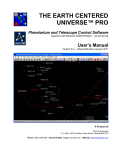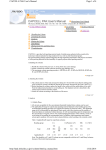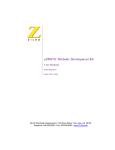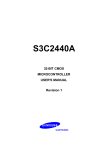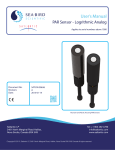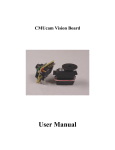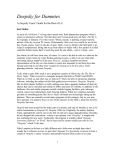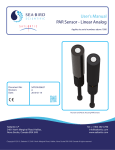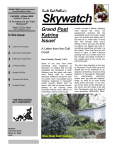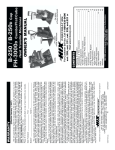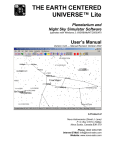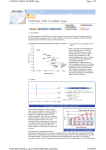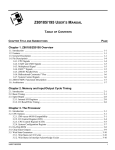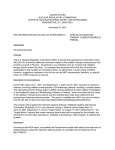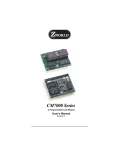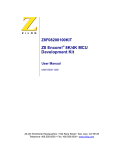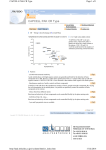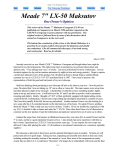Download MICRO-GUIDER III - Nova Astronomics
Transcript
MICRO-GUIDER III A Telescope to Computer Interface Device You Can Build by David Lane, Nova Astronomics updated - June 16, 1997 INTRODUCTION... The Micro-Guider III (MGIII) is a telescope to computer interface device based on my previous project, the Micro-Guider I. The original Micro-Guider I is a self-contained device which provides a telescope with digital setting circles, complete with a database of almost 8,000 celestial objects including the Messiers and the NGCs. It interacts with the user using an LCD display and a 16 button keypad. A detailed multi-part article entitled: “MICRO-GUIDER I: A Computerized Setting Circle/ Database Device You Can Build” was published in Observatory Techniques #6 and #7 (Summer and Fall 1993). The MGIII is a scaled-down version which reads the telescope’s azimuth and altitude and transmits it to a suitable computer program upon request. This article will describe the MGIII’s hardware, software, and construction. It is the author’s intent to provide enough information here to allow the electronics-inclined telescope maker to build the device themselves. To aid in building the MGIII, the author has available a supply of blank printed circuit boards and the programmed EPROM chip needed to complete the device. Some other components may also be available. DESCRIPTION... The MGIII is a device which connects to a telescope by using two optical encoders, one attached to each axis of rotation. The optical encoders translate the rotational movements of the telescope into electrical signals which are interpreted by the MGIII’s on-board microprocessor. The current position of the telescope is transmitted to a computer upon request using a standard RS232 interface. The MGIII is used in conjunction with a suitable computer program which can translate the telescope’s coordinates into right ascension and declination and act as an aid in locating objects at the eyepiece (preferably in a graphical way). The MGIII is designed to be compatible with the author’s shareware Planetarium and Telescope Control Program for Microsoft® Windows™: The Earth Centered Universe™ (ECU). It is also compatible with other programs. ECU provides the interface between the telescope, the MGIII, and the user. I will not discuss the operation of ECU in this article, since the operating procedures are documented in ECU’s User’s Manual. As is normal practice with modern digital setting circles, the MGIII will work equally well with equatorial or alt-azimuth mounted telescopes, since it does not require polar alignment or mount levelling. Once aligned, ECU provides all the necessary mathematical conversions to use the elapsed time and the azimuth and altitude (from the MGIII) to calculate the current right ascension and declination. To initialize the system, ECU asks the user to point the telescope at two stars. Polar aligned equatorial telescopes need to be aligned on only one star. HARDWARE... The MGIII’s hardware consists of one printed circuit board; the same one used in the original MicroGuider I except with fewer components installed. The schematic diagrams of the circuit board are depicted in Figure 1. The chassis wiring interconnecting the circuit board and the other components is shown in Figure 2 . This section provides a brief description of how the MGIII works, however it is not required for the reader to understand how the hardware works to build the device. The architecture of the MGIII is based on Hitachi’s HD64180 microprocessor. This microprocessor is a highly integrated version of the older Zilog Z80 microprocessor. Components C2, C3, X1 comprise the main oscillator which is used to time all functions of the computer. U6 is the EPROM chip (32k bytes) which is used to store the MGIII’s software. U5 provides 32K bytes of RAM for use by the software. Not all of this RAM is used; in fact an 8K byte device is sufficient. The components mentioned in the previous paragraph form a complete fully operational computer. But a computer by itself, with no input/output, is all but useless. U11 is used to read the outputs from the encoders. Components U13, and C17-C20 are used to provide the RS232 interface. U12 is used to regulate positive five volts, which powers all of the circuitry. The minimum operating voltage is seven volts, but it will operate properly up to at least 15 volts. The current consumption of the complete MGIII is about 30mA, plus the current used by the encoders (the US Digital encoders consume about 17mA each). This will provide several hours operation from a standard 9V battery. I use a 12 volt 6 amp-hour gel-cell battery, which provides power for about a season of observing! SOFTWARE... As mentioned above, the MGIII is basically a dedicated computer, thus the software reflects greatly in its functionality. The software was written in a combination of the ‘C’ programming language and assembly language. An important part of the software is the encoder routines, written in assembly language. The optical encoders are read by the software at a rate of 8000 times per second. Each optical encoder produces two signals which are used to determine the motion (including the direction) of each telescope shaft. The software interprets these signals to determine the azimuth and altitude of the telescope. The remaining part of the program is the interface with the RS232 port. The port is configured at 9600 baud, eight data bits, and one stop bit. This portion is written in ‘C’. There are several commands supported. The main command ‘Q’, queries the MGIII to transmit the current telescope position. It responds immediately by sending the azimuth and altitude out the RS232 port to the connected computer. The format transmitted is shown below: +00123<tab>+00456<cr> where: +00123 is the azimuth <tab>is an ascii tab character (decimal 9) +00456 is the altitude <cr>is an ascii carriage return character (decimal 13) The resolution of the encoders define the range of output expected in the azimuth and altitude readings. If 4000 count encoders are used, the range of output is -2000 to +1999 representing the angles -180 to +180 degrees. Several other commands can be sent to the MGIII for such functions as setting the encoder resolution, determining the number of encoder errors (if any), etc. Determining the right ascension and declination of the telescope is quite complex and is calculated by the PC computer connected to the MGIII. The algorithm which The Earth Centered Universe™ uses is described in an article published in the Astronomical Computing column of the February 1989 Sky and Telescope magazine. CONSTRUCTION... The construction of the MGIII is quite straight forward. The parts list shown below lists all the materials necessary to build the MGIII. Most are available from mail order outlets which cater to the hobbyist (consult the advertisements in a recent electronics hobbiest magazine). If materials sourcing proves difficult, the author is willing to assist the prospective builder. Many of the actual components listed in the parts list are only suggestions, and many substitutes are possible. The total cost of the parts is approximately $200US, including the two optical encoders. The hardware for mounting the encoders to the telescope axis’ will not be discussed here, since every telescope will require different mounting hardware. The circuit board should be populated according to the silkscreen markings on the PCB. Be careful to note the polarity of the diodes and capacitors and the orientation of the integrated circuits. Be particularly careful with U2 and its socket. Only install the components identified in the parts list. All of the other components are not required, since they are used only by the original Micro-Guider I, which has a real time clock, an LCD, and a keypad. Components U2, and U6 should be socketed. The remaining IC’s can be socketed, if desired. The chassis wiring can be performed using ribbon cable, as I have used, following the wiring diagram shown as Figure 2. PARTS LIST... Resistors: R1.................................................................................................................................. 10K, 0.25W, 5% R12,R16 ...................................................................................................................... 100K, 0.25W, 5% Capacitors: C1,C6 ........................................................................................ 10uF, 25V tantalum (0.2" lead spacing) C5,C7,C8,C9,C12,C16 .............................................................. 0.1uF, 50V, ceramic (0.2" lead spacing) C2,C3 ......................................................................................... 22pF, 50V, ceramic (0.2" lead spacing) C17,C18,C19,C20 ..................................................................... 22uF, 16V, tantalum (0.2" lead spacing) Semi-Conductors: X1 ............................................................................................ 12.288MHz crystal (HC-18/U case style) D1...................................................................................................................................... 1N4001 diode U1.......................................................................................................................................... 74HC14 IC U2.....................................................Hitachi HD64180RCP-8X or Zilog Z8018006VSC microprocessor (Available from the author for $10US) U3,U4 ......................................................................................................................... 74HC138 decoder U5............................................................................................. Hitachi HM62256LP-12 32K static RAM U6............................................................................................................ 27C256 EPROM Programmed (available from the author for $15US) U11 ...................................................................................................................................... 74HC373 IC U12 ......................................................................................................................7805 IC (TO-220 case) U13 ..................................................................................................................... Maxim MAX232CPE IC Miscellaneous: 1 ...............................................................................................................................printed circuit board (Available from the author for $35US) 1 ................................................................................................................. 68 pin PLCC socket (for U2) 1 ....................................................................................................................... 28 pin IC socket (for U6) 2 ......................................................................................................10 contact double row straight male headers for J4, J6 (0.1" pin spacing) 1 ................................................................................................................................. suitable enclosure 2 ................................................... US Digital Corp. S1-1000 (0.09 degree resolution) optical encoders. Phone (800) 736-0194 or (206) 696-2468 2 ................................................................................................................................. DB-9P connectors 2 ................................................................................................................................. DB-9S connectors 2 ...................................................................................................... 10 pin IDC ribbon cable connectors 2 ................................................................................................ encoder mountings (telescope specific) RS232 cable to PC (straight through wiring DB-9S to DB-9P) Assorted wire and ribbon cable Assorted hardware CONCLUSION... The MGIII provides an inexpensive and easy to build digital setting circle device. The author’s inexpensive shareware program for Microsoft® Windows™: The Earth Centered Universe (ECU) provides full support for the MGIII and many other telescopes. ECU, a full featured planetarium and telescope control program, is available from the author for $50US. The “shareware” version is available here. David J. Lane, Nova Astronomics PO Box 31013 - Halifax, Nova Scotia, Canada, B3K 5T9 Phone: (902) 443-5989 evenings - Fax: (902) 445-5790 Compuserve ID: 71601,247 E-mail: [email protected] MICRO-GUIDER III - CONTROLLER BOARD MEMORY C2 22p X1 12M288 C3 2 3 4 5 6 7 8 9 10 11 12 13 14 15 16 17 19 20 21 22 23 24 25 26 27 28 29 30 31 32 33 34 22p U1 +5V 4 RES 74HC14 1N4001 U1 1 + A0 A1 A2 A3 A4 A5 A6 A7 A8 A9 A10 A11 A12 A13 A14 A15 A16 A17 A18 2 C1 74HC14 10u SPARE GATES E0H U1 13 12 74HC14 U1 11 INT2 100K 10 74HC14 U1 9 +5V 8 RD WR ADDRESS DECODING MREQ IORQ A15 A16 A17 1 2 3 MREQ A18 4 5 6 +5V RX1 TX1 U3 A0 A1 A2 E1 E2 E3 15 14 13 12 11 10 9 7 00000H 08000H GND 62256 1 2 3 IORQ A3 A7 4 5 6 U4 A0 A1 A2 0 1 2 3 4 5 6 7 E1 E2 E3 15 14 13 12 11 10 9 7 U1 EOH 2 6 C18 POWER REGULATOR U12 VBATT V+ C1+ C5 +5V 2 + 0u1 C2+ C6 C7 C8 C9 C10 C11 10u 0u1 0u1 0u1 28 +5V 11 12 13 15 16 17 18 19 D0 D1 D2 D3 D4 D5 D6 D7 22 1 20 RD WR 14 00000H 0u1 +5V TX0 TX1 J6 5 J6 6 RX0 RX1 J6 7 J6 8 14 7 13 8 1 + T1OUT T2OUT R1IN R2IN 0u1 T1IN T2IN R1OUT R2OUT GND C19 22u 3 D0 D1 D2 D3 D4 D5 D6 D7 2 5 6 9 12 15 16 19 Q0 Q1 Q2 Q3 Q4 Q5 Q6 Q7 OE E D0 D1 D2 D3 D4 D5 D6 D7 1 11 3 4 7 8 13 14 17 18 EOH 1 J4 +5V 2 J4 3 J4 CHA-RA CHB-RA 5 J4 6 J4 CHA-DEC CHB-DEC 9 J4 GND 74HC373 4 + MAX232 22u C2- POWER SUPPLY DECOUPLING 7805 3 OUT GND C20 5 11 10 12 9 22u TX0 TX1 RX0 RX1 15 FIGURE 1 MARCH 10, 1992 MICRO-GUIDER III WIRING DIAGRAM AUGUST 19, 1995 GND RS232-TX RS232-RX RS232 INTERFACE 3 AZIMUTH ENCODER S1/S2 SERIES ALTITUDE ENCODER S1/S2 SERIES N/C N/C 5 2 J3 (DB-9S) N/C J6 9 J6 10 IN + V- 1 2 3 4 5 6 7 8 9 10 GND GND 1 GND 27C256 VCC C1- J6 1 J6 2 00 01 02 03 04 05 06 07 OE VPP CE U11 U13 74HC14 VBATT VBATT U6 14 08000H 16 C17 + 22u R16 100K RD WR +5V BOH MICROPROCESSOR 6 22 27 20 A0 A1 A2 A3 A4 A5 A6 A7 A8 A9 A10 A11 A12 A13 A14 RS232 INTERFACE 74HC138 5 D0 D1 D2 D3 D4 D5 D6 D7 VCC 10 9 8 7 6 5 4 3 25 24 21 23 2 26 27 ENCODER INTERFACE A4 A5 A6 HD64180RCP-8X 74HC14 OE WR CE 11 12 13 15 16 17 18 19 A0 A1 A2 A3 A4 A5 A6 A7 A8 A9 A10 A11 A12 A13 A14 74HC138 RX0 TX0 D7 D6 D5 D4 D3 D2 D1 D0 0 1 2 3 4 5 6 7 00 01 02 03 04 05 06 07 +5V IN4001 J6 GND 10K R12 68 67 66 65 64 63 62 61 60 59 58 57 56 55 54 53 51 50 49 48 47 46 45 44 43 42 41 40 39 38 37 1 35 36 U5 28 CH. B +5V CH. A D1 CLK RD WR LIR E ME IOE REF HALT TEND1 DREQ1 CKS RXS TXS TEND0 RXA1 TXA1 DREQ0 RXA0 TXA0 DCD0 CTS0 RTS0 D7 D6 D5 D4 D3 D2 D1 D0 GND1 GND3 GND4 VCC A0 A1 A2 A3 A4 A5 A6 A7 A8 A9 A10 A11 A12 A13 A14 GND R1 GND2 XTAL EXTAL WAIT BUSACK BUSREQ RESET NMI INT0 INT1 INT2 ST A0 A1 A2 A3 A4 A5 A6 A7 A8 A9 A10 A11 A12 A13 A14 A15 A16 A17 A18 VCC 10 9 8 7 6 5 4 3 25 24 21 23 2 26 1 CH. B +5V CH. A 3 +5V U2 A0 A1 A2 A3 A4 A5 A6 A7 A8 A9 A10 A11 A12 A13 A14 DB-9S MICRO GUIDER III CONTROLLER BOARD J4 1 2 3 5 6 9 4 N/C 7 N/C 8 N/C 10 N/C +5V CH. A - AZIMUTH CH. B - AZIMUTH CH. A - ALTITUDE CH. B - ALTITUDE GROUND 1 2 3 5 9 6 8 7 +8-15V GND J2 (DB-9P) FIGURE 2 ALL DIMENSIONS IN INCHES. S1/S2 OPTICAL SHAFT ENCODERS DESCRIPTION: The S1 or S2 series optical shaft encoder is a noncontacting rotary to digital converter. Useful for position feedback or manual interface, the encoder converts realtime shaft angle, speed and direction into TTL-compatible quadrature outputs with or without index. The encoder utilizes an unbreakable mylar disk, metal shaft and bushing, LED light source, monolithic electronics and operates from a single +5 volt supply. Available with ball bearings for motion control applications or torque-loaded to feel like a potentiometer for front-panel manual interface. FEATURES: • Small size • Low cost • 2-channel quadrature, TTL square wave outputs • 3rd channel index option • Tracks from 0 to 100,000 cycles/sec • Ball bearing option tracks to 10,000 RPM • -40 to +100∞C operating temperature • Single +5v supply MECHANICAL SPECIFICATIONS: All Options: Vibration: 20 g, 5 to 2KHz max. Acceleration: 250,000 rad/sec2 max. Sleeve bushing (non-ball bearing) Shaft Speed: 100 RPM max. continuous Shaft rotation: Continuous and reversible Shaft torque: 0.5±0.2 in. oz. 0.3 in. oz. max. (NT-option) Shaft loading: 2 lbs. max. dynamic 20 lbs. max. static Weight: 0.7 oz. Shaft runout: .0015 T.I.R. max. Ball Bearing Option: Shaft Speed: 10,000 RPM max. continuous Acceleration: 50K Rad/Sec2 10K Rad/Sec2 (SP-1000 Series) Shaft torque: 0.05 in. oz. max. Shaft loading: 1 lb. max. Bearing Life: (40/P)3 = Life in millions of revs. where P=radial load in pounds Weight: 0.7 oz. Shaft runout: .0015 T.I.R. max. MATERIALS: Shaft: Bushing: Connector: Brass or Stainless Brass Gold plated MOUNTING: Hole Diameter: Panel Thickness: .380 in. .125 in. max ELECTRICAL SPECIFICATIONS: B leads A in a clockwise shaft rotation, and A leads B in clockwise shaft rotation viewed from the mounting surface side of the encoder. ACCESSORIES: Cables and Connectors ORDERING INFORMATION: U.S. Digital Corp. 3800 N.E. 68th St., Suite A3 Vancouver, WA 98661-1353 800-736-0194 206-696-2468 Fax 206-696-2469 http://www.usdigital.com/ FOR MORE INFORMATION VISIT THE US DIGITAL WEB SITE… http://www.usdigital.com






